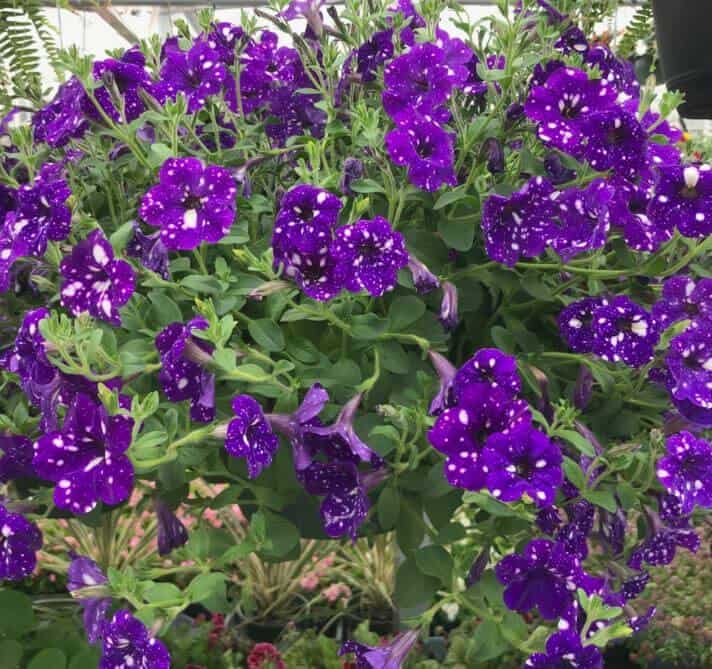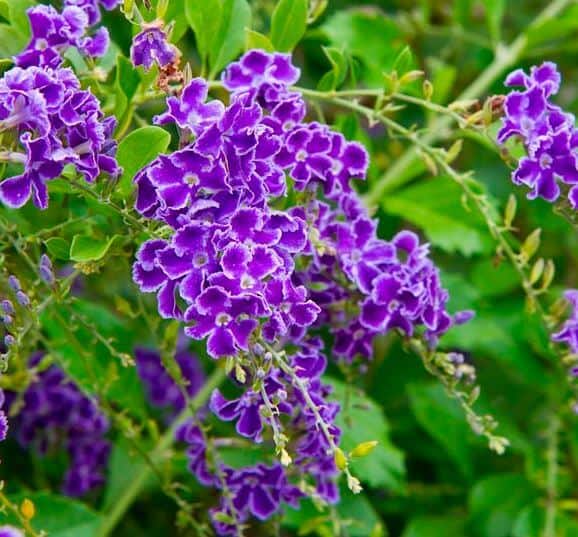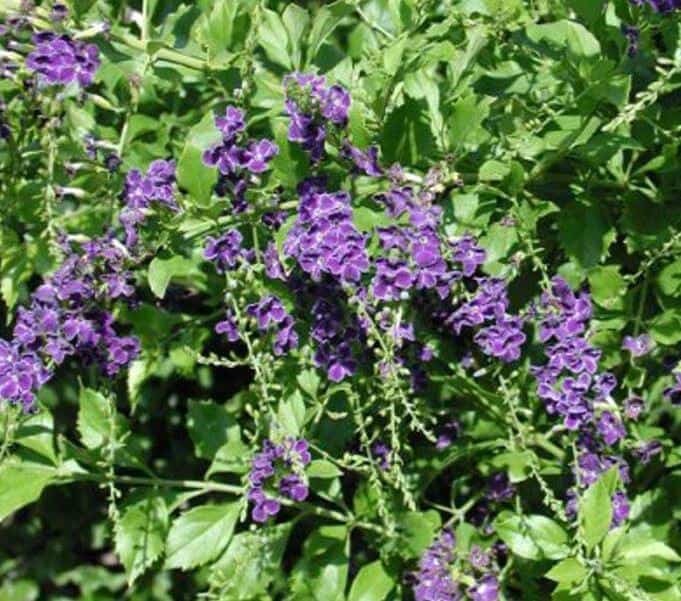Last Updated on January 6, 2023 by a Friendly Gardener
The sweet memory plant, also known as the Duranta plant, is a tropical outdoor shrub. It is also grown indoors. The plant has attractive evergreen foliage with two-inch long oval or rounded leaves and clusters of violet flowers.
The ornamental plant is perfect for growing in patio containers and adds an exceptionally colorful vibe to your surroundings. If you follow the basic care requirements, you will get blooms all year round.
Below, you will find everything about sweet memory plant care.
Sweet Memory Plant Care

The sweet memories plant, botanically christened Duranta erecta, is a tropical broadleaf evergreen that grows up to four feet tall as an annual plant. It can get as tall as 18 feet when grown as a perennial.
The plant belongs to the verbena family and delivers clusters of violet-pale blue blossoms during its growing season. In fall, the plant sports orange or yellow berries that appear in drooping clusters.
Despite it being an ornamental shrub, it is considered an invasive species in certain areas.
It is an easy-to-grow plant, growing fast under proper care, and requires minimal maintenance. The plant is well-suited for the hardiness zones 10 to 11. In warm regions, the small flowering shrub can transform into a small tree in just a few years.
The leaves and berries of the plant are considered to have a toxic effect on humans and pets. It is advised to exercise caution around the plant if you have pets in the house.
Below are the basic instructions for taking care of the Duranta sweet memory plant.
Light
This plant loves the sun and prefers being planted in a sunny location. It needs the full force of the sun to bloom and bear berries. Though it can tolerate shade, too much shade can result in a sparse and lanky plant.
Water

You should feed new plantings water on a daily basis for a few weeks. Once the Duranta plant becomes established, it needs to be moderately watered. The water level can be adjusted based on the soil type and weather. Sandy soil will need frequent watering compared to clay soil.
If you are growing the plant outdoors, you will need to water it up to an inch every week. If you are growing it in containers, wait for the top layer of the soil to dry before watering your Duranta.
Soil
In order to maximize the growth potential of the Duranta plant, make sure to use rich, loamy soil. The plants can withstand lean soil if it has good draining capabilities.
Fertilizer
This plant does not have much need for supplemental fertilizer and can survive without heavy feed. However, if you are growing the plant in rock or lean soil, you can enrich the growing medium with a general fertilizer once every four weeks during its growing season.
Make sure to follow instructions on the fertilizer package to avoid overfeeding the plant, as too much fertilizer can prove detrimental to the plant’s health.
Temperature and Humidity
The Duranta is a warm-weather plant. It does not tolerate frost conditions. If you have planted it in a container, watch out for when temperatures drop below 40℉ and bring the plant indoors.
They handle humid and dry climates quite well and tolerate salty beach climates to a certain extent.
Pruning

In colder climates, pruning the plant keeps it from growing out of bounds and choking neighboring plants. Since new growth comes with flowers, it is a good idea to prune the plant during winter to allow for fresh spring growth.
Pruning keeps the plant healthy and prevents unnecessary energy drainage. Instead, the energy gets redirected to stimulating dense growth during the growing season.
Propagation

If you want to expand the sweet memory plant population, you can propagate it using stem cuttings. Snip a six-inch cutting during summer and rub some rooting compound to its base. Get a pot filled with a well-draining soil mixture and plant the cutting in it.
Keep the soil mix moist until the cutting sprouts roots and new growth begins. Once it is actively growing, you can transplant the sapling to a bigger pot or your desired outdoor location.
You can also grow the plant from the seed. However, it is not recommended. If an exact match to the parent is not your concern, you can use the seeds from the ripe berries of the sweet memory plant and grow yourself some new plants.
Plant the seeds lightly in a moist potting mix. You should see the seeds germinate in a month or two at 70℉.
Overwintering
Make sure you bring in the Duranta plant before the temperature outside begins to drop. Place them on the sill of a sunny window or make arrangements to provide the plant with plenty of artificial light. Meager light will lead to unhealthy growth.
In cold zones, garden plants are usually uprooted and discarded once the growing season comes to an end.
However, if you are growing them indoors or have warm winter conditions, you can grow them as perennials. The plants become semi-dormant during the winter and require single feeding as opposed to growing months.
Potting and Repotting

The sweet memory plant does not mind the container culture. It adapts to growing within the boundaries of a pot. Make sure to pick a large pot with good drainage and quality potting soil mix to grow this plant.
In case your plant starts to look unhealthy, or if its roots begin to poke out of the soil, you will need to upgrade the pot size. Be extremely careful when moving the Duranta from one to another, as larger plants can have inch-long sharp spines.
Conclusion
The sweet memory plant can be easily grown in your patio garden or in containers indoors. It requires plenty of sunlight, well-drained moist soil, moderate watering, and minimal feeding.
It is a fast-growing plant that can quickly change the look of your landscape with its attractive foliage and flowers. They are easy annual plants to grow. In case you are growing it as a perennial, you may have to put in some additional effort, such as annual pruning, to keep it well-shaped and tidy.


